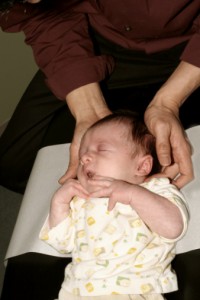 Klumpke’s palsy is a type of paralysis that results from damage to the brachial plexus, a network of nerves that originates at the top of the spinal cord near the base of the neck. A baby’s brachial plexus nerves may become injured during a difficult delivery, and Klumpke’s palsy can result.
Klumpke’s palsy is a type of paralysis that results from damage to the brachial plexus, a network of nerves that originates at the top of the spinal cord near the base of the neck. A baby’s brachial plexus nerves may become injured during a difficult delivery, and Klumpke’s palsy can result.
Klumpke’s palsy can have a debilitating effect and prevent a child from having movement and sensation in the forearm and hand. The condition can be permanent in some instances. If your child has suffered damage to the brachial plexus nerves that caused Klumpke’s palsy, it is important to understand your legal rights. An experienced birth injury lawyer at the Ginarte law firm can help.
Speak With A Knowledgeable Professional
The New York and New Jersey birth injury lawyers at Ginarte Gonzalez Winograd L.L.P., represent people who have been injured by medical mistakes and errors. To find out what your legal options are, contact the firm now by calling 1-888-GINARTE (1-888-446-2783) or use our online form. Consultations are free. We collect fees only if you win your case.
About Klumpke’s Palsy
The brachial plexus nerve network can be damaged as a result of excessive stretching, which is called neurapraxia. In some cases, scar tissue forms as a result of damage to the nerves, which can cause a neuroma. In other instances, the nerves can tear away from the spine, which is called an avulsion, or can rupture.
Trauma can affect different nerves in the brachial plexus. If only the upper nerves are harmed, a child may develop Erb’s palsy. If the damage is to the lower roots of the nerves, a child may develop Klumpke’s palsy.
A child with Klumpke’s palsy may experience paralysis and have limited sensation in the muscles of the hand and forearm. A child may have some limited motion, but may experience muscle weakness. In cases where the injury is severe, an affected child may also experience a droopy eyelid on the same side of the body as the hand and arm with limited movement.
In some cases, Klumpke’s palsy heals within a few months and the child is able to recover normal feeling and mobility. In other cases, the damage is permanent and the child will experience weakness, limited mobility or paralysis for the rest of his or her life. This type of permanent injury is most common in situations in which the nerves were torn or scar tissue formed.
Treatment for Klumpke’s Palsy
Treatment for Klumpke’s palsy varies. Typically, a doctor will diagnose the condition based on symptoms including a lack of muscle control in the hand and arm. X-rays of the neck, an MRI and nerve conduction tests such as NVCs or EMGs are also commonly used in diagnosis. Children may be referred to a pediatric neurologist if Klumpke’s palsy is suspected.
Speak With A Knowledgeable Professional
A child who has been diagnosed with Klumpke’s palsy may undergo a therapy regimen involving early immobilization followed by passive movements in order to prevent fibrosis in the muscles and connecting tissues that would limit mobility when the nerves heal. In severe cases such as ruptures, nerve grafting or a nerve transplant may be necessary. These are surgical treatments in which a portion of the damaged nerve is replaced or the entire nerve is replaced by other nerves from other parts of the body.
If surgery, physical therapy and time do not heal the nerves, then the Klumpke’s palsy may be permanent, and the child may require adaptive devices and ongoing assistance for life.
Who is Responsible for Klumpke’s Palsy?
Klumpke’s palsy is sometimes caused by birth injuries that result from medical negligence. Problems are especially likely to occur with large babies or with mothers who have had prior Caesarean sections, who have gestational diabetes or who have a small pelvis.
Common forms of medical negligence that cause Klumpke’s palsy include:
- If a doctor is too aggressive in extracting the baby from the birth canal, especially when using a vacuum or forceps.
- If a doctor allows labor to go on for too long, fails to recognize signs of fetal distress or fails to order a necessary Caesarean section.
- When shoulder dystocia develops (the baby becomes lodged behind the mother’s pubic bone) and a doctor fails to respond promptly and correctly.
In these and other situations, it is essential to consider what the health care provider did – or did not – do. Doctors, hospitals and other professional caregivers are expected to provide quality care at the level that a reasonable professional would have offered in the same situation. If a caregiver falls short and offers substandard care, this can give rise to a medical malpractice lawsuit for birth injuries.
Getting Legal Help If You or Your Child Has Klumpke’s Palsy
The birth injury attorneys at Ginarte Gonzalez Winograd L.L.P., can help families who have been affected by birth injuries related to medical negligence. We have extensive experience evaluating and pursuing claims concerning children who have been injured by acts of medical malpractice and negligence. We work with pediatric and obstetric experts with a vast knowledge of neonatal and postnatal development in determining the causes of injuries and disabilities in infants and children.
Speak With A Knowledgeable Professional
If you are the parent of a son or daughter with Klumpke’s palsy or another birth injury, please contact us for immediate attention at 1-888-GINARTE (1-888-446-2783) or use our online form for a free consultation.
